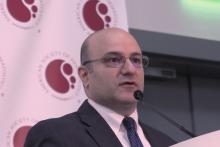SAN DIEGO – The success or failure of hematopoietic cell transplants may be related to the diversity of species in the gut microbiome, investigators contend.
A study of fecal samples from patients scheduled to undergo hematopoietic cell transplant (HCT) in the United States, Europe, and Japan showed that intestinal microbial diversity was significantly associated with overall survival, reported Jonathan U. Peled, MD, PhD, from the bone marrow transplantation service at Memorial Sloan Kettering Cancer Center in New York City.
“Patients with low diversity pretransplant have a poorer overall survival than patients with a higher diversity after transplantation,” he said at the annual meeting of the American Society of Hematology. “The implication is, if we could come up with a way to remediate microbiome injury, there might be time to implement it before the transplant.”
There are about 100 trillion symbiotic microbes in and on the human body, and 95% of them live in the gastrointestinal tract, which has a surface area that if stretched out would equal the size of two tennis courts, Dr. Peled said.
Previous studies by his group and others have shown that the composition of intestinal microbiota is associated with survival, relapses, graft-versus-host disease, and infections in patients in the early weeks after allogeneic HCT.
The international team previously reported that intestinal diversity measured around the time of neutrophil engraftment was predictive of overall survival, and they hypothesized that the same might be true of the pretransplant microbiota composition.
To test this idea, they collected 1,922 stools samples approximately once weekly for 3 weeks pretransplant from 991 adult patients scheduled for allo-HCT for various diagnoses in two U.S. cohorts and one cohort each in Europe and Japan.
They found that on average patients in all four cohorts had microbiota diversity values ranging from 70% to 150% lower than those of healthy volunteers whose samples were sequenced by the investigators, as well as those in a publicly available database.
The investigators also asked whether one or more bacterial species accounted for 30% or more of a microbiome, a phenomenon known as “monodomination.”
“A third, or in some cases 95+%, of bacteria in an individual’s intestine are all the exact same strain,” Dr. Peled said.
They found that the incidence and prevalence of the monodomination phenotype was “strikingly similar” at all four transplant sites.
The patterns of microbiota injury were similar despite differences in antibiotic strategies among the four centers and different dietary patterns of patients in the regions studied.
Studies in animal models suggest that T cells responsible for graft-versus-host disease migrate to the gut as early as 2 or 3 days post transplant, and by that time more than half of transplant patients have a monodomination event in their guts, Dr. Peled said.
Some strategies to remediate or prevent microbiome damage – and potentially improve HCT outcomes – may include the use of over-the-counter or custom-made probiotics, fecal transplants, a “prebiotic” approach in which the patient is asked to follow a specific diet that promotes the growth of beneficial bacteria, or a “postbiotic” approach in which patients receive metabolites of agents or foods thought to have a beneficial effect.
“Finally, we can think about different antibiotic strategies, to use or not use different types of antibiotics at different times in a rational way,” Dr. Peled said.
Dr. Peled reported current or prior financial relationships with Seres Therapeutics, the Parker Institute for Cancer Immunotherapy, and Merck/Society for Immunotherapy of Cancer.
SOURCE: Peled JU et al. ASH 2018, Abstract 811.


